

Material tactility, its possibilities, limitations, and transformation form the core of Kelly Akashi's practice. Often using her own hands as a subject, the artist captures momentary gestures, casting them into perpetual existence. Drawing attention to the fluidity and interconnectedness of the media she uses, Akashi aims to capture the tension and physicality of objects in her practice.
Kelly Akashi has a major solo exhibtion at the San Jose Museum of Art, enttitled Formations. The exhibtion will travel to the Frye Art Museum in Seattle and then to the Museum of Contempoirary Art, San Diego.
Akashi has created an intervention with Villa Aurora’s architectural heritage and history on the occasion of Frieze LA Projects, curated by Jay Ezra Nayssan.

Kelly AKASHI
Life Forms
2023
Lost-wax cast bronze and hand-blown glass
23 x 6 1/2 x 7 inches; 58.4 x 16.5 x 17.8 cm

Building on her investigation of visual perception, Barth's series Deep Blue Day explores notions of the atmospheric and ephemeral through light as it shifts over time. Here, for the first time in her practice, Barth overtly manipulates her surroundings by drawing the folds of her living room curtains in order to shape shifting rays of sunlight over the course of an afternoon. While photography is always about light and exposure, this work is a beautiful example of Barth's new engagement with light, where she uses it in an almost sculptural or performative way.
Uta Barth’s solo exhibition Peripheral Vision at The J. Paul Getty Center is on view through February 19, 2023.
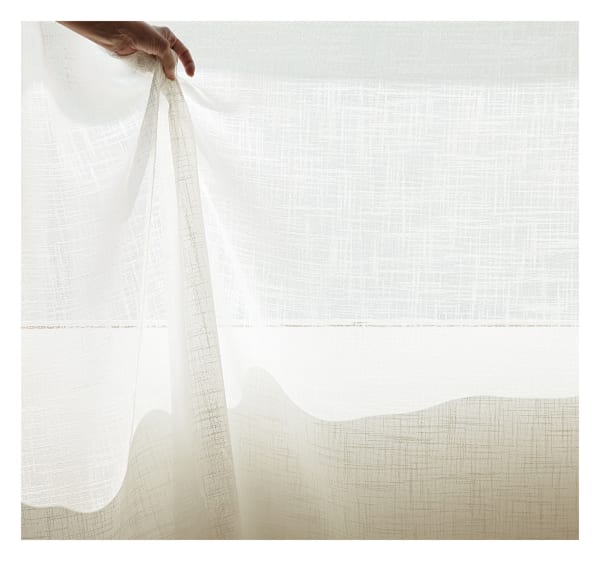
Uta BARTH
Deep Blue Day (Untitled 12.4)
2012
inkjet print face-mounted against matte acrylic, framed in painted aluminum frame
37 5/8 x 40 3/8 inches; 95.6 x 102.5 cm
Edition of 6, 2 APs

Among the most important artists of her generation, Monica Bonvicini’s evocative and thought-provoking sculptures, installations, texts, photographs, videos and public projects explore the relationship between architecture, gender and power.
As sculptural and performative object, the mirrored surface of Love is Blind (0001) invites the audience to act out their voyeurism in seeing and being seen. The viewers experience a roller coaster of impressions: from fascination, and acting and posing in front of the mirroring surfaces, to a chill in the face of the seemingly impermeable and cold character of the sculpture. Decorated with chains and handcuffs, Love is Blind (0001) reflects on design ideas, dogmas, and utopias that are also inscribed in Museums, Galleries and Art Fairs.

Monica Bonvicini
Love Is Blind (0001)
2022
Mirror, stainless steel, chain, handcuff
59 x 39 3/8 x 1 3/4 inches; 150 x 100 x 4.5 cm

Martin Boyce’s works poetically investigate the intersections between art, architecture, design, and nature. Since the beginning of his career, he has incorporated a palette of shapes and forms that frequently recall familiar structures from the built environment, yet presents them in a way that is entirely new. Collapsing distinctions between past, present, and future, Boyce’s works seem to exist in their own autonomous world, untethered to any fixed time or place.
Long Distance (I Remember Everything) incorporates the recognizable form of the wall-mounted telephone set against a large, perforated panel painted pink. While the phone seems to be a relic of a bygone era, the retrofuturist color and design make it seem like an oracle from the future. Alluding to its battle against obsolescence, Boyce examines the phone’s territorial relationship as a portal between two fixed points in space and time and observes the conditions and circumstances in which information and memory operate in relation to today’s digital technology.
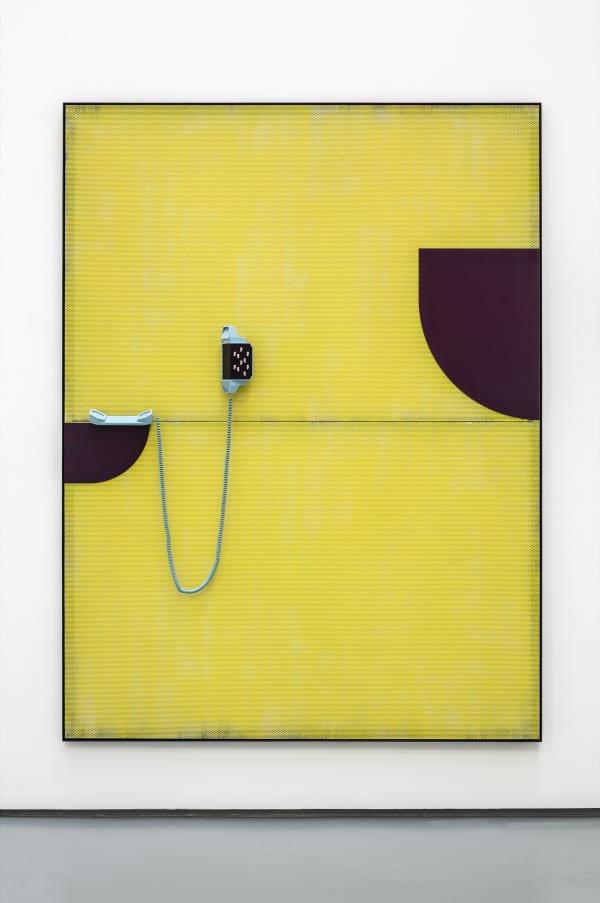
Martin BOYCE
Long Distance (I Remember Everything)
2022
Painted aluminium, painted perforated steel, painted and stained steel, painted silicone moulded vacuum cast resin, coiled telephone cable
86 5/8 x 64 15/16 x 1 1/2 inches; 220 x 165 x 4 cm


The colour-current dilemma, 2022, consists of twenty-four elliptical panes of colourful, handblown glass arranged in three rows one above the other. Each row presents a different progression of ellipses: the top and bottom rows wax and wane towards either end, while the middle progresses from an almost circular disc at one side to a flattened ellipse at the other.
This work exploits the inherent visual confusion of the ellipse, which, depending on the context, can give the illusion of a circular disc viewed in perspective. Here, the ellipses shift upon their axes as well, creating the sense that the disc is rotating and tumbling at the same time. Ripples and bubbles in the handblown glass enhance the overall effect of fluidity and movement.
The backs of the glass panes are silvered so that they function as mirrors, reflecting the viewer and their surroundings in the particular monotone of the glass. The choice of colours and their arrangement on the wall corresponds to the tones of the subtractive colour model, progressing from magenta to yellow to cyan and back to magenta.

Olafur ELIASSON
The colour-current dilemma
2022
Silvered coloured glass (shades of rainbow spectrum), composite board, aluminium
64 1/2 x 130 3/4 x 1 3/8 inches; 164 x 332 x 3.5 cm


Remarkable in execution and detail, Fragmented Painting is produced through an intimate logic that has now become signature to Manders' practice. Rendered in cast bronze, the sculptural portrait appears to be soft clay mid-way through the process of becoming a sculpture. In casting the sculpture in bronze, the artist freezes a very specific moment in time, highlighting the fragility of every moment that passes. The manipulation of material generates a sense of puzzlement and awe, masterfully creating a sense of timelessness - while the sculpture seems to be just made, it is at the same time enigmatically atemporal.
Mark Manders has a solo exhibition at Tanya Bonakdar Gallery, Los Angeles on view February 11 - April 8, 2023.

Mark MANDERS
Fragmented Painting
2022
Painted bronze, painted canvas, wood
16 3/4 x 20 1/2 x 18 7/8 inches; 42.5 x 52 x 48 cm
Edition of 3, 1 AP


Nathalie Djurberg and Hans Berg’s new series of sculptural flowers offer a fragile beauty and an untamable, organic logic of their own. Constructed from mixed media – employing modelling clay, paint, fabric and resin – the sculptures recall real species of lilies or orchids, as well as fantastical floral arrangements in other-worldly colors and forms. Flowers recur in Djurberg & Berg’s practice due to their abiding interest in the fleeting nature of human emotions and their shared symbolism for human themes of love, joy, desire, sadness and vulnerability. Representing the circle of life, from a shy bud to a beautiful blossom to a withering plant, the flower form has been a constant interest in Djurberg and Berg’s practice.
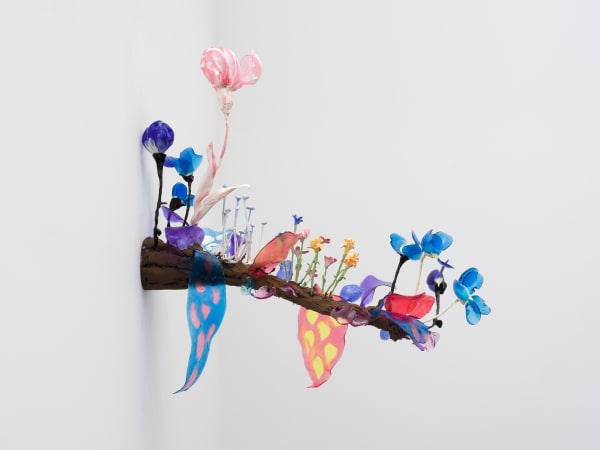
Nathalie Djurberg & Hans Berg
Night Flower on Wood (66 cm)
2022
Metal, glassfiber, epoxy putty, grout, resin, wire, polymer clay, acrylic paint
27 x 26 x 13 inches; 68.6 x 66 x 33 cm

Lisa Oppenheim’s starting point for Entartete Kunst, Sonnenblumen, 1919/2023 (Version II) was an image of a 1919 painting of sunflowers in the catalogue raisonné of works by Max Pechstein, a German expressionist painter and member of the Die Brücke group. More than 300 works by Pechstein were removed from German museums during the Nazi era and were deemed ‘degenerate’ by Joseph Goebbels’ Ministry of Propaganda. A selection of the seized works were shown at the infamous ‘Degenerate Art’ exhibition, which opened in Munich in 1937 and subsequently toured across the Reich. This painting was recorded as stolen and was never restituted. Oppenheim transforms the archival image and solarizes the photograph with firelight, using her signature smoke technique.
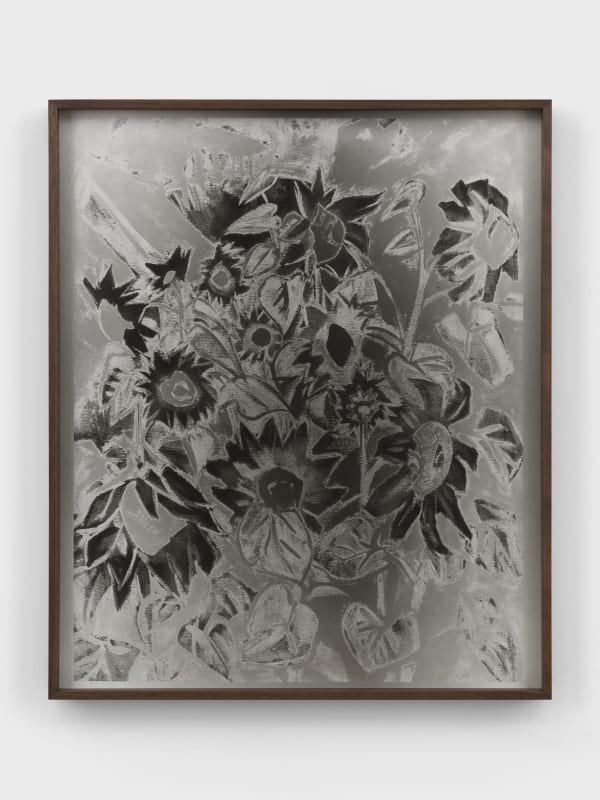
Lisa Oppenheim
Entartete Kunst, Sonnenblumen, 1919/2023 (Version II)
2023
Silver gelatin photograph exposed to firelight
23 5/8 x 19 7/16 inches; 60 x 49.4 cm (unframed)
24 1/4 x 20 3/8 x 1 1/2 inches; 61.6 x 51.8 x 3.8 cm (framed)


Encompassing sculpture, performance, installation, video, and drawing, Amalia Pica’s work examines systems of communication and what brings people together. Using seemingly simple materials and found objects, she investigates human modes of interaction, especially our desire to be understood and the accompanying pleasures and failures. Pica considers shared visual codes associated with verbal and nonverbal language systems – often incorporating playful signifiers of collective expression and cultural celebration – ultimately exploring cultural intimacy and the political potential of joy. As a result, her work has a lightness of touch and a feel-good quality, which Pica prioritizes for its power to draw viewers into a conversation.
In her ongoing Catachresis on paper series, Pica focuses on the rhetorical device known as catachresis, the application of terms that apply to things that do not have their own word, such as the teeth of a comb, leg of a chair, tongue of a shoe or elbow of a pipe. Pica collages together colorful images of inanimate objects to explore the flexibility of language and its possibly comical consequences. The Catachresis works demonstrate the importance of humor in her practice and remind us of the great lengths we go to to achieve communication and understanding.

Amalia Pica
Catachresis on paper #41 (face of the mirror, spine of the book, face of the crystal, shower head, boca de jarro, leg of the table)
2022
Collage
14 1/4 x 11 1/2 x 1 inches 36.2 x 29.2 x 2.5 cm (framed)

Dana Powell's small-scale oil paintings depict moments of transition and anticipation. They take the shape of night drives, full moons, swimming pools, elevator doors, still lifes with fruit, explosions, and peep holes. Unrelated at first look, these subjects prove malleable apparatus in demonstrating the unsettling power of the ordinary, and emotive potential of small shifts in formal painting strategies. Considered austerity is applied to Powell’s tableaus of the everyday, offering a window to the familiar and its undertow.

Dana POWELL
Harvest Moon
2022
Oil on linen
8 x 8 inches; 20.3 x 20.3 cm



168.810 gives visual form to vivid memories of the ten months Roland spent wrongfully incarcerated. In this white steel sculpture, he recalls the experience of spending day after day in prison, when he would often pass the time by tracing the outlines of the white cinder blocks that formed his two-man cell. Running his fingers horizontally and vertically, back and forth along the spaces between the blocks, he would take note of the difference in texture; the soft, smooth mortar contrasting sharply with the cold, hardness of the cinder blocks, providing a rare source of sensory stimulation. The repetitive, tactile action became a form of meditation that offered a mental escape to the freedom beyond the physical confines of the prison cell.
Roland recreates the idea of the soft area between cinder blocks by filling the steel channels with acrylic paint mixed with Kool- Aid, a beverage readily available in prison. This colorful, sweet drink brought back memories of Roland’s childhood when it was served at family gatherings to kids, a time of innocence which he often reflected upon during these moments of meditative escape. By tracing these areas around the cinder blocks, he was able to imagine leaving through the cracks and returning to the free world outside, demonstrating the power of touch and action to transport our minds elsewhere.
Sherrill Roland has a major solo exhibition on view at the Asheville Art Museum, on view through March 20, 2023.

Sherrill Roland
168.810
2022
Steel, enamel, Kool-Aid, acrylic medium, epoxy resin
41 x 33 1/2 x 33 1/2 inches; 104.1 x 85.1 x 85.1 cm



Analia Saban
Area Chart (Blue Values)
2023
Woven acrylic paint and linen thread on panel
72 x 69 1/2 x 2 1/4 inches; 182.9 x 176.5 x 5.7 cm


Aeolic Cluster 628.3 advances Saraceno’s long-standing artistic inquiry Air-Port-City / Cloud City, a proposal for for airborne habitats as a new, alternative form of urbanism. This work is composed of a number of interconnected modules constructed from mirrored hand-blown glass, a material that, like clouds, exists at the intersection of air, water, and earth. In nature, matter floats through the atmosphere until it clusters together to form groups of clouds. The irregular facets of the sculpture are inspired by the geometry of the Weaire-Phelan structure, found in the way foam and soap bubbles form. The reflective surfaces illuminate an aqueous world of gold and silver, where boundaries become fluid and human spatial coordinates are challenged. What alternative ways of being emerge through a momentary immersion in this floating, shimmering world of light?

Tomás SARACENO
Aeolic Cluster 628.3
2022
Hand blown glass mirrored
5 module part: 9 7/8 x 13 x 10 1/4 inches; 25 x 33 x 26 cm
3 module part: 8 5/8 x 10 5/8 x 9 7/8 inches; 22 x 27 x 25 cm

Throughout the past two decades, Gillian Wearing’s films, photographs and sculptures have investigated public personas and private lives. Since the beginning of her career, the artist has drawn from techniques of theater, reality television and fly-on-the-wall documentary-making to construct narratives that explore personal fantasies and confessions, individual traumas, cultural histories, and the role of the media. Anonymity through elaborate masks, costumes and role-play has remained a critical part of Wearing’s practice and influential investigation of the ways in which individuals present themselves to others when the self is temporarily concealed.
Self Portrait at Twenty Seven Years Old is part of an ongoing series of self-portraits that Wearing makes at different stages in her life, often by recreating old photographs and donning masks of herself at a younger age. Here, Wearing poses as her younger self at 27 years old.

Gillian WEARING
Self Portrait at Twenty Seven Years Old
2012
Digital C-print
80 3/4 x 18 1/2 x 1 1/2 inches; 205 x 47 x 3.8 cm (framed)
Edition of 6, 2 APs


Interested in language and its inevitable abstraction, Lisa Williamson leans into the formal considerations of sculpture to create works that are visually precise, physically resonant, and often attune to the spaces in which they are exhibited. The artist’s idiosyncratic practice follows a logic that is associative; compressing internal experience into forms that are both tangible and resistant at once. While there is a significant level of reduction and abstraction throughout the artist’s work, aspects of architecture, landscape and the figure remain visible throughout.
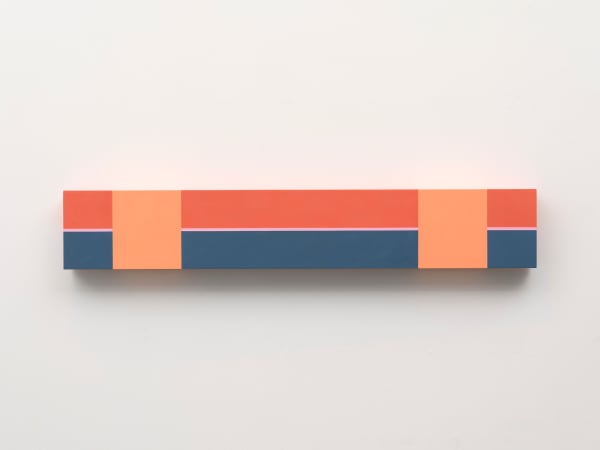
Lisa Williamson
Bar Clutch
2023
Flashe, acrylic, water-based urethane on primed aluminum and steel
8 x 48 x 3 1/2 inches; 20.3 x 121.9 x 8.9 cm